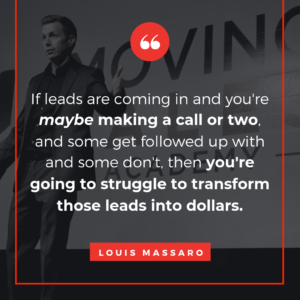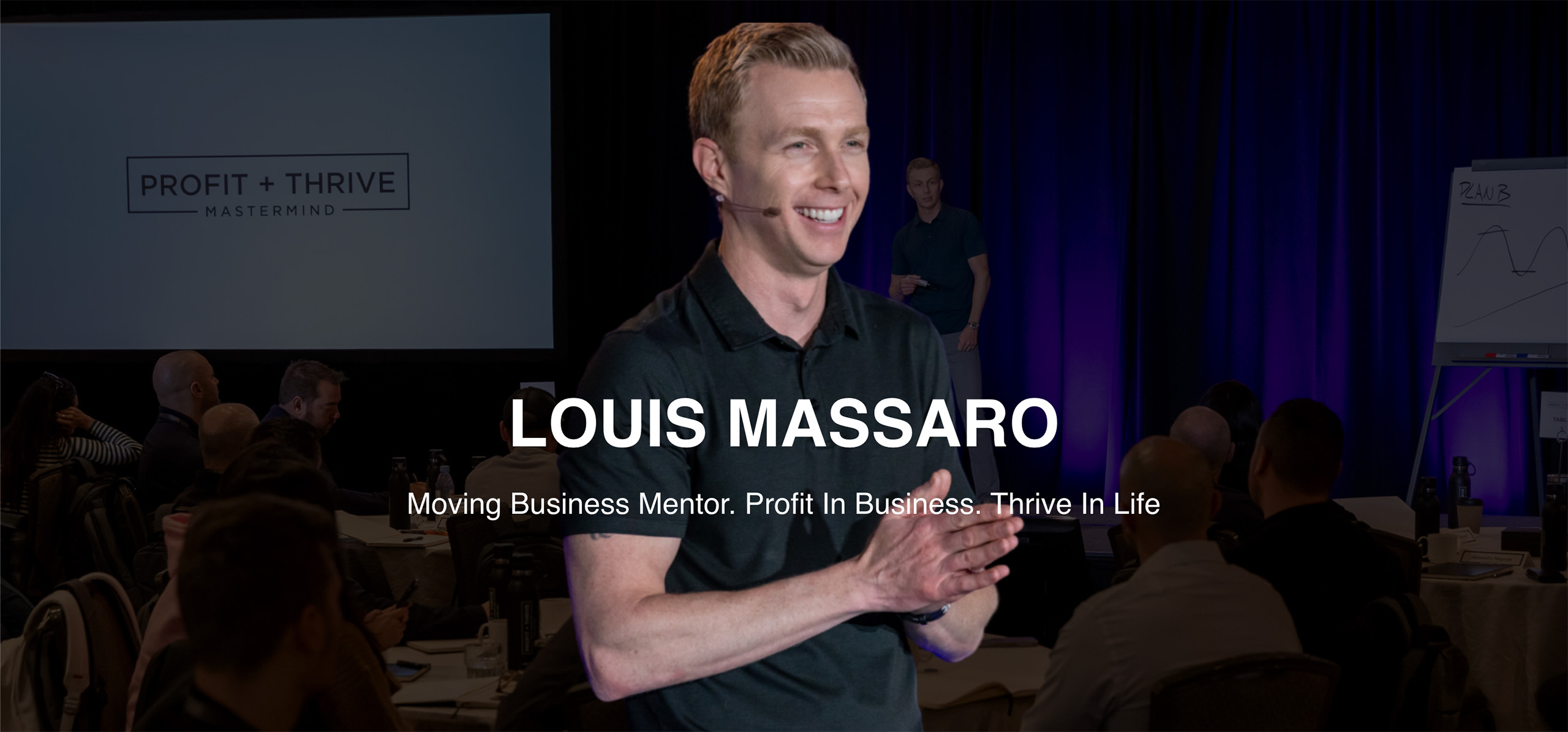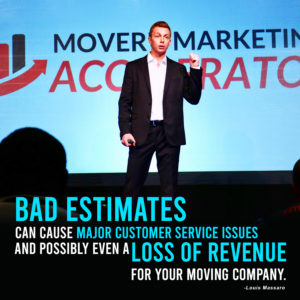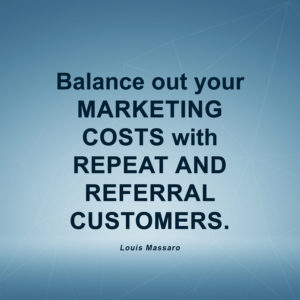[fb_button]
► Get New Posts Via Email ► Get This Episode On iTunes
SUMMARY
In this video, Louis Massaro shares his process for successfully managing moving leads.
- “3-Point Lead Management” Look at your lead management process. Make sure it’s on point before you give up a potentially lucrative lead source just because there’s a lot of inefficiencies going on within the sales department.
- “Lead Capture” Make sure your web forms are set up to get all the customer’s information, make sure that on phone calls your team is getting that information before they even move forward.
- “Lead Distribution” It’s all about getting the right lead into the right hands of the right person that’s going to be able to get that job closed.
- “Lead Follow-up” Making sure that your sales team is actually calling leads as many times as you want them to call them.
- “Maximize Your Leads” Implement this process and turn your leads into dollars.
- Watch the video to get full training.
HOT NEWS & DEALS!
- Join the Moving CEO Challenge: Official Louis Massaro Community Facebook Group! A place for moving company owners to connect, share ideas, and inspire one another. Click here to join!
- Latest Instagram!
Check out @LouisMassaro for new announcements, valuable tips, and enlightening videos to take your moving company to the NEXT LEVEL!
RELATED POSTS
Prioritize Moving Leads to Book More Moves
Buy Moving Leads and Book More Moves
How To Convert Bad Moving Leads
Manage Your Moving Company’s Marketing
Why Moving Companies Are Failing In Marketing


Transcription
Hey, my friend, it’s Louis Massaro, CEO, Moving Mastery, where we help moving company owners set up proven systems and processes to increase profits, reduce stress, and live a better quality of life. You know, one of the things I hear from clients all the time is the frustration when it comes to spending money on marketing, right? Buying leads from either a lead provider or maybe some Google AdWords or even direct mail, you know, any type of marketing that they’re doing for their moving company, the actual management of those leads. Meaning once their sales team gets those leads, they feel uncertain about what’s happening with them. Are they calling them quickly? Are they calling them enough? What’s the contact method that they’re using, and they’re not quite sure, like how many leads should each person have, right? How many follow-ups should they be doing? What should we do when the phone rings and someone calls in? Baterii pentru stivuitoare https://batteriesromania.com/ .
It’s a deep level of frustration for a lot of people because they spend a lot of money on marketing. They know that their movers are out there doing a great job for their customers and they’re just kind of confused as to what they should be doing with all of these leads. Because as we know from just statistics of, you know, me running my call center and clients of mine, if you’re working the leads, they turn into money, right? But if they’re coming in and you’re maybe making a call or two and some get followed up with and some don’t, and your sales team doesn’t really have any accountability, you’re going to struggle to turn the leads into dollars.
When I say leads, it’s really any type of an opportunity that you have, right? So that could be a phone call coming in from a referral. It could be an actual lead from a moving company lead provider. It could be from your website, it could be from a pay-per-click campaign, it could be direct mail, it could be from anywhere. That’s a lead, right? So what I tell people is in order to get this under control, you need to set up lead management. In particular, you need to set up what I call three-point lead management.
You know, when I first started in the moving business, there was really nothing but YellowPages. We had YellowPages, I was out pounding the pavement, going to some apartment complexes, and then I got into some direct mail. But there was no leads, there was nothing coming into my CRM where I had their name, their phone number, their email address. It was just all phone calls. Back then they called, we tried to book it, we didn’t book it, we kind of moved on, right? Nowadays we have really such a golden opportunity with the amount of data that we have coming in from these different leads and all the information and all the technology and all this stuff that we could do to follow up with them to book more. So even though it’s more complex than the simplicity of just the phone rings from YellowPages and you book moves, there’s more opportunity now than ever.
But how do you do that? How do you set up three-point lead management? Well, the first step, the first thing you need to do … it’s broken up into three different phases, and it’s important not to just look at lead management as one thing, but to break it up into these three components.
The first component is called lead capture. What is lead capture? Lead capture is basically making sure that you get all of the information that you need from every single opportunity. Whether it’s coming in off a web form from your website or a phone call, you need to make sure that you’re capturing their name, their phone number, their email address, the date they’re looking to move, where they’re looking to move from, and where they’re looking to move to. Every single time. Where I see a lot of companies fail with this is on incoming phone calls. Someone will call in, “Hey, I’m looking for an estimate.” “Okay, great. I could help you.” And they just start going into the estimate. You must start capturing that information.
Let me tell you why that’s so important. You know, with the modern technology that we have these days, you have things like email automation, where you could be automatically emailing customers, not only on the front end but on the back end, to re-engage them years, years, and years later, to be able to get them back as a customer. You’ve got text messages, you’ve got the ability to send out mail pieces to them as well. But if you don’t have their information, especially their phone number, to be able to follow back up with them if you don’t book it on the first job, on the first call, you’re done. You’re done.
What happens is, even if … you know, I see this struggle with moving company owners all the time. Like I tell my team, they have to get the info, but they don’t really tell them how to go about getting the info. It has to be done in a very strategic way and it has to … there’s certain things that you have to say in order to be able to capture that information from a customer.
When a customer calls in and they want a quote, “Oh, no problem, what’s your name by the way?” You know? “Oh, John, hi John, my name’s Louis. Nice to meet you. Listen, just in case we get disconnected today, what’s the best phone number to call you back at? Okay.” If you have caller ID, you could just pull it off the caller ID and then you tell them, “At the end of this call, I’m going to go ahead and send you out an email with all the information we discussed along with an accurate estimate for your move. What’s the best email address to send that to?” Done. You’ve got their name, email, phone number, and then you’re going to of course get where they’re moving from and where they’re moving to because that’s part of the estimate, but make sure you always give them a reason why you’re asking for their email address. People are fed up with spam. They don’t want to give out their email address unless there’s a reason for it. So if you’re letting them know they’re going to get all the information you discussed plus an accurate estimate at the end, they’ll give you the correct email address, right? Now you have that information to be used later on for things like email automation, for things like after the move, making sure that you can get reviews as well.
It’s so important that you capture that data. Even certain ad campaigns and things that you could do with Facebook, that’s a whole nother topic, right? If you have that data, you could target certain people directly. So the first thing is lead capture. Make sure your web forms are set up to get that information, make sure that your phone calls, your team is getting that before they even move forward.
Second part of the three-point lead management system is called lead distribution. When a new call comes in, when a new lead comes directly into your CRM, to where, you know, you get it from a lead provider, comes from your website. That should go directly into your CRM, your customer relation management system. Those of you who don’t know, I’m co-founder in SmartMoving CRM. You could check that out, but any CRM should be able to do this, to where it imports directly from your website into your software, directly from lead providers into your software.
But now, once you have that information, remember there’s two types of leads. You’ve got the lead that’s a web lead where they’re just submitting information, and then you’ve got the phone call. You typically won’t have someone coming and knocking on the door of your moving company asking for a quote, unless you’ve got great exposure and visibility somewhere and, you know, occasionally you get a walk-in, but typically it’s a web lead or it’s a phone call.
Once you get those, it’s important that you establish a system of how you’re going to distribute those leads amongst your team. So here’s some things you want to consider. Not all leads are equal. You’ve got your hot leads, you’ve got your not-so-hot leads, and then you kind of got your eh leads. So who do you want to get the hot leads? You know, there’s nothing wrong with allowing your top people to get the good leads and allowing your new people that are still in training, or are still in their first couple of weeks, to get some of the leads that don’t perform as well. Then you might have certain people that handle local moves and other people to handle long distance moves. Lead distribution also means how quick you are getting those leads into someone’s hands so that they can call them. Lead distribution’s all about getting the right lead into the right hands of the right person that’s going to be able to get that job closed.
Then you have to decide how many leads each moving consultant in your company should have each and every day. It’s important to know so that you know how many they could work, you know what’s too much and what’s too little. There is such a thing as having too many leads. I know it’s hard to believe that. A lot of people say, “Louis, you can never have too many leads,” but you can because if you have a full-on sales process, like we teach at Moving Sales Academy, if you have everything in place and you have too many leads, you could be choking on those leads. Those leads could be congesting the whole system. You want to make sure that you have the right amount of leads per rep so that it flows evenly, so you have to decide on that.
You also want to make sure that you’re deciding, you know, what the accountability is for your team, right? You need a certain amount of dials. If you have leads, you need a certain amount of dials, so you want to be able to track that in your phone system. How many outbound calls are they making a day? They might sit in the seat for eight hours, but what are they really doing? The only way you can know if your sales team is actually working is how many phone calls they’re making or how many hours of talk time they have on the phone. How many dials they’re making to new leads and followup of people that they’ve already spoken to, and how much talk time. Talk time is important, because if they’re not actually talking to people and they’re just making dials and not getting anyone on the phone, they’re not going to be able to book any jobs. So you want to have a minimum amount of dials and a minimum amount of talk time that they have to hit one or two of those. So that’s lead distribution, making sure you get the right lead in the right hands of the right person who’s going to be able to book that job.
The third part of the three-point lead management system is lead follow up. What is lead follow up? Lead follow up is how many times are you going to call that lead? You want to try to get them on the phone as soon as possible, as a new web lead comes in, let’s say it’s not a phone call, let’s say it’s a web lead off your website. You want to get them on the phone as soon as possible.
You want to also determine how many times you’re going to actually reach out to them before you say, you know what, we haven’t been able to get ahold of them, let’s move on. Because I’m sure you’ve gotten leads before that you were never able to get ahold of the people, right? You’ve called, you’ve emailed, you’ve text, but they never call you back. Well, there comes a point where you have to move on and so you have to decide, all right … And this is part of your system. This is part of your structure. If you don’t have the structure in place, the process in place, and you’ve got everybody just doing what they want to do, then your company is basically a accumulation of just this person, what they think is best and what that person thinks best, and typically not even what they think is best, but just in the mood that they’re in that day. This person’s having a bad day, they don’t feel like making calls, your leads aren’t being called. If you determine, hey, you need to call the leads this many times on the first day, this many times on the second day, then it’s done, and you could track in your CRM if they’ve actually made those calls or not.
That’s lead follow up. Making sure that they’re actually calling them as many times as you want them to call them. Remember, if you have systems in place where everybody does things the same way, that’s how you could scale. That’s how your company becomes much easier to manage. That’s how you close the holes in the bucket where the money’s fallen through, because as leads come in, think about a bucket, right? Leads are coming in, phone calls are coming in, they’re coming into the bucket, and you’ve got a bunch of holes at the bottom, which pretty much is, you know, when I see it in companies it’s in lead capture, lead distribution, and lead follow up.
When there’s holes there, the money’s following through and you’re not keeping it, so you want to plug those holes with the lead capture. You want to plug those holes with determining your lead distribution policy. You want to plug those holes with setting up the lead follow up to where everyone is doing it the same way. That’s how you maximize your marketing spend. That’s how you stop getting so frustrating and saying that lead provider doesn’t work … which could be true, right? It could be true. However, before you ever, ever, ever say this lead provider is not working, you first need to look at your sales process. You first need to look at your lead management process. Make sure that’s on point before you give up a potentially really, really lucrative lead source just because there’s a lot of inefficiencies going on within the sales department.
Three-point lead management, that’s how you maximize your leads. That’s how you turn leads into dollars. I hope that was helpful, my friend. If so, do me a favor. Make sure you share this with somebody out on social media or a friend who might find this valuable. If you could hit the like button, I’d really appreciate it. Until I see you next time, go out there every single day, profit in your business, thrive in your life. Thanks so much. I’ll see you later.




















